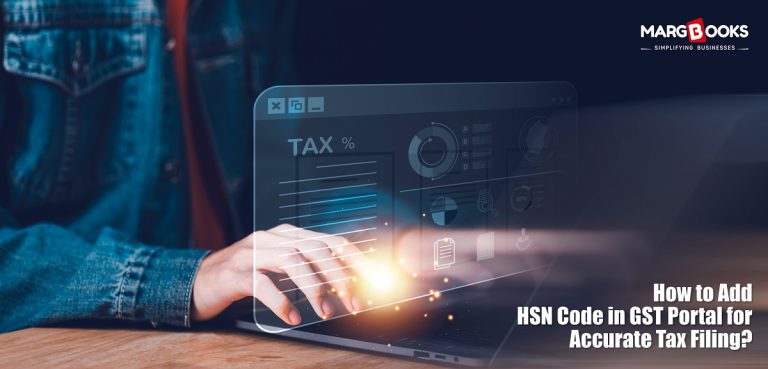The Goods and Services Tax (GST) regime in India has simplified tax processes but also brought about the need for detailed documentation and compliance. One such requirement is the addition of the HSN (Harmonized System of Nomenclature) code for goods and services on the GST portal. Whether you’re a small business owner or an enterprise, understanding how to add HSN code in the GST portal is crucial for accurate tax filing.
In this blog, we will guide you through the process of adding the HSN code in the GST portal, and how using online GST software and inventory management software, MargBooks can help streamline your business’s compliance efforts.
What is HSN Code and Why is it Important?
The HSN code is a globally recognized system of classifying goods. In India, businesses need to mention the HSN code of products they deal with in their GST returns. The HSN system is used to ensure uniformity and ease in international trade and taxation. When you file GST returns, you need to specify the correct HSN code for every item you deal with, as it directly impacts your tax rate and ensures you’re complying with GST rules.
Using the right HSN code ensures that:
- The correct tax rate is applied to your goods.
- You avoid penalties for non-compliance.
- Your returns are processed smoothly without discrepancies.
How to Add HSN Code in GST Portal?
Adding the HSN code to the GST portal is a simple process but requires careful attention to detail. Follow these steps to add the HSN code for your goods or services:
Step 1: Log in to the GST Portal
The first step is to log in to the GST portal (www.gst.gov.in) using your credentials. If you don’t have access, you will need to create a GST account for your business.
Step 2: Go to the ‘Services’ Tab
Once you’re logged in, navigate to the ‘Services’ tab on the dashboard. From the drop-down menu, select the ‘Returns’ option.
Step 3: Choose the ‘GST Returns’ Option
Next, select ‘GST Returns’. This will direct you to the screen where you can file your GST returns for the relevant period.
Step 4: Select the Return Type (GSTR-1 or GSTR-3B)
Depending on your requirement, choose the appropriate return type – GSTR-1 (for outward supplies) or GSTR-3B (for summarised GST return).
Step 5: Fill in the Details of Goods or Services
In the return form, you will have to provide details about the goods or services you are supplying. This is where you will mention the HSN code. Here’s how you do it:
- For GSTR-1: Under the ‘Sales’ section, you will see a column to enter the HSN code for the goods.
- For GSTR-3B: In the section for ‘Outward Supplies’, you will be required to input the HSN code for the goods you’ve sold.
Step 6: Validate and Submit
Once you have added the HSN code for all relevant goods or services, review the information to ensure there are no errors. After validation, you can submit your returns.
Common Mistakes to Avoid While Adding HSN Codes
Adding the HSN code might seem straightforward, but there are a few mistakes that businesses often make. Here are some tips to avoid them:
- Incorrect HSN Code: Ensure you are using the correct HSN code for the goods you’re selling. Using the wrong code could lead to mismatched tax rates.
- Not Updating HSN Code: If you add new products or services, make sure you update the corresponding HSN codes in your GST returns.
- Missing HSN Codes: Failing to mention the HSN code, especially for high-value transactions, could result in fines and delayed processing of returns.
Benefits of Using Online GST Software for HSN Code Filing
Filing GST returns manually can be a tedious process. Using online GST software can simplify the process of adding HSN codes, generating accurate tax calculations, and ensuring seamless filing. Here’s how online GST software helps:
1. Automated HSN Code Suggestions
Most online GST software, such as MargBooks, offers features that automatically suggest the correct HSN code based on the product category. This minimizes human error and saves time.
2. Easy Tax Calculations
With accurate HSN codes entered into the system, online GST software can automatically calculate the applicable tax rates for each product. This ensures you don’t make mistakes while filing taxes.
3. Simplified GST Return Filing
Online GST software integrates directly with the GST portal, allowing for seamless GST return filing. With just a few clicks, your returns are filed, and HSN codes are properly included.
4. Error-Free Compliance
GST compliance can be tricky, but with online GST software, you get reminders for filing dates, and the software ensures that your HSN codes are correctly entered in each return. This reduces the risk of penalties due to non-compliance.
How Inventory Management Software Can Help?
Along with online GST software, inventory management software like MargBooks can play a pivotal role in helping businesses manage their HSN codes more effectively.
1. Centralized Product Catalog
Inventory management software allows businesses to maintain a centralized catalog of all products. This helps in adding the correct HSN code to each product in the system, which is then automatically applied during GST filing.
2. Track Stock and HSN Code
The software keeps track of both your stock levels and the corresponding HSN codes for each item. This means that when you make a sale, the system automatically includes the right HSN code on invoices and GST returns.
3. Real-time Updates
If your products change or new products are added to your inventory, MargBooks and similar inventory management software will let you update the HSN codes in real time, ensuring that your GST filings are always up-to-date.
Conclusion
In the ever-evolving landscape of GST in India, knowing how to add HSN code in GST portal is essential for every business. Properly entered HSN codes not only ensure accurate tax filing but also help avoid penalties.
Leveraging online GST software and inventory management software like MargBooks makes the entire process of GST filing more efficient, reducing the chance of errors and ensuring compliance. By adopting such tools, you’ll save valuable time, improve tax accuracy, and focus on growing your business.
Whether you’re a startup or an established company, integrating these technologies into your business operations will streamline your tax processes and make GST compliance hassle-free.




